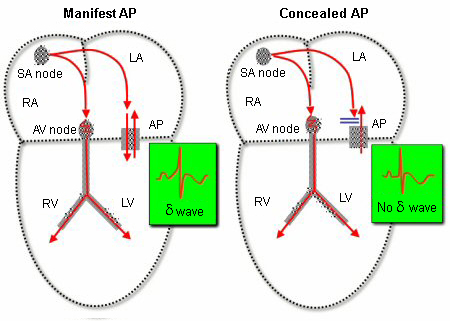Summary
Definition
History and exam
Key diagnostic factors
- presence of risk factors
- atrioventricular re-entrant tachycardia (AVRT)
Other diagnostic factors
- palpitations
- dizziness
- shortness of breath
- chest pain
- atrial fibrillation
- atrial flutter
- congenital cardiac abnormalities
- sudden cardiac death
- syncope and presyncope
- tachycardia in pregnancy
Risk factors
- Ebstein's anomaly
- hypertrophic cardiomyopathy
- mitral valve prolapse
- atrial septal defect
- ventricular septal defect
- transposition of great vessels
- coarctation of aorta
- dextrocardia
- coronary sinus diverticula
- right and left atrial aneurysms
- cardiac rhabdomyomas
- Marfan's syndrome
- Friedreich's ataxia
- family history
Diagnostic investigations
Treatment algorithm
Contributors
Authors
Hugh Calkins, MD
Professor of Medicine
Director of Electrophysiology
Johns Hopkins University School of Medicine
Baltimore
MD
Disclosures
HC declares that he is a consultant for Medtronic, Biosense Webster, Abbott, and Boston Scientific.
Acknowledgements
We would like to acknowledge our cardiology expert panel member, Dr Fred Kusumoto, for his contribution to this topic.
Professor Hugh Calkins would like to gratefully acknowledge Dr David Frankel, Dr Mithilesh K. Das, and Dr Douglas P. Zipes, previous contributors to this topic.
Disclosures
DF, MKD, and DPZ declare that they have no competing interests.
Peer reviewers
Nicolas Palaskas, MD, FACC
Assistant Professor
University of Texas MD Anderson Cancer Center
Houston
TX
Disclosures
NP declares that he has no competing interests.
Joseph E. Marine, MD
Associate Professor of Medicine
Director of Electrophysiology
Johns Hopkins University School of Medicine
Baltimore
MD
Disclosures
JEM declares that he has no competing interests.
Suneet Mittal, MD
Director
Electrophysiology Laboratory
The St. Luke's-Roosevelt Hospital Center
New York
NY
Disclosures
SM declares that he has no competing interests.
Andrew Turley, MB ChB
Cardiology Specialist Registrar
The James Cook University Hospital
Middlesbrough
UK
Disclosures
AT declares that he has no competing interests.
Steve Hsu, MD
Associate Professor
Department of Medicine
Division of Cardiology
University of Florida College of Medicine
Jacksonville
FL
Disclosures
SH declares that he has no competing interests.
Peer reviewer acknowledgements
BMJ Best Practice topics are updated on a rolling basis in line with developments in evidence and guidance. The peer reviewers listed here have reviewed the content at least once during the history of the topic.
Disclosures
Peer reviewer affiliations and disclosures pertain to the time of the review.
References
Key articles
Brugada J, Katritsis DG, Arbelo E, et al. 2019 ESC Guidelines for the management of patients with supraventricular tachycardiaThe Task Force for the management of patients with supraventricular tachycardia of the European Society of Cardiology (ESC). Eur Heart J. 2020 Feb 1;41(5):655-720.Full text Abstract
Zeppenfeld K, Tfelt-Hansen J, de Riva M, et al. 2022 ESC Guidelines for the management of patients with ventricular arrhythmias and the prevention of sudden cardiac death. Eur Heart J. 2022 Oct 21;43(40):3997-4126.Full text Abstract
Page RL, Joglar JA, Caldwell MA, et al. 2015 ACC/AHA/HRS guideline for the management of adult patients with supraventricular tachycardia: a report of the American College of Cardiology/American Heart Association Task Force on Clinical Practice Guidelines and the Heart Rhythm Society. J Am Coll Cardiol. 2016;67:e27-e115.Full text Abstract
Reference articles
A full list of sources referenced in this topic is available here.
Use of this content is subject to our disclaimer
